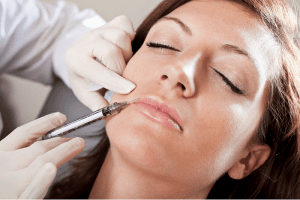Quick fix dermal filler products include such widely recognized products as Botox, Juvederm, and Restylane. These substances, when properly injected by an experienced clinician, can eliminate obvious signs of aging such as wrinkles, crows’ feet beside the eyes, and forehead creasing.
How Do They Work?
While Botox works beneath the dermal layer to relax those muscles that when contracting, form expressive lines on the face, Juvederm and Restylane work within the skin layer to immediately fill and voluminize the flesh on the face and then provide nutritive revitalization for the longer term. They are especially effective in smoothing areas around the mouth and nose.
Application
Because all three of these dermal fillers require application via injection into facial tissues, they call for the services of a licensed clinician. Only the experienced expert can judge the correct quantity of filler and the proper areas for application. A professional office venue is the safest, most sterile and quality-controlled environment for treatments of this kind.
Industry Concerns
In recent years, especially since sales of Botox, Juvederm and Restylane no longer require a physician’s prescription, more sources are making these dermal fillers available to the general public. People have the option to buy the products directly or online. Incredibly, people are actually giving themselves a do-it-yourself quick facial fix by self-injecting dermal fill substances.
This practice is raising considerable concern among the medical community. Some clinicians point out that medical supplies from unproven sources can easily be counterfeit or substandard products that may cause unwanted side effects. Others focus on the fact that an untrained individual is hardly qualified to judge quantities and injection sites. Amateur applications of Botox, Restylane, or Juvederm can produce some surprising and sometimes alarming results.
Self-injection of dermal fillers can cause redness and infection, excessive swelling, scarring, bleeding, and migration of fillers to undesirable areas of the face. When you inject fillers around your eyes and forehead, you can create droopy eyelids or areas of swelling that a physician may find hard to reverse.
Conclusions
The majority of individuals self-injecting dermal fillers do so to save professional fees. Yet when you consider the potential health problems and side effects that often require a doctor’s intervention later, these do-it-yourselfers rarely save much, and often manage to make themselves look worse rather than better. An initial investment in professional injection of dermal fillers undeniably produces the best results.

 differences among them are how long they take, what they are made of, and how they work.
differences among them are how long they take, what they are made of, and how they work.









